Bhupesh Chandra Semwal* , Neha Singh and Shilpi Pathak
, Neha Singh and Shilpi Pathak
Department of Pharmacology, Institute of Pharmaceutical Research GLA University, Mathura, U.P. -281406 India
Corresponding Author E-mail: bhupesh115@gmail.com
DOI : https://dx.doi.org/10.13005/bpj/2335
Abstract
Turnip is an ancient edible plant belongs to family Braaicacaceae. Traditionally it is used for the treatment of various disorders such as diabetes, hepatotoxicity, ulcer, and anti-inflammatory activity. Therefore the current investigation was attempted to investigate the anti-inflammatory activity of Brassica rapa root extract against complete fluids adjuvant induced inflammation in experimental animals. The Ethanol extract of Brassica rapa was prepared by a hot extraction procedure and phytochemical analysis of different extract was done by different chemical tests. Daily oral treatment of indomethacin, and extract for twenty-one days after three days of CFA administration significantly decrease the paw volume, hepatic biomarkers as well as ameliorated the level of a hematological parameter such as hemoglobin, RBC, WBC, ESR and bodyweight of experimental animals. From the result of the current investigation, it can be concluded that the Brassica rapa extract possesses anti-inflammatory activity. Further study is required to explore the mechanism responsible for its anti-inflammatory activity.
Keywords
Arthritis; Brassica rapa; CFA; ESR; Hemoglobin
Download this article as:| Copy the following to cite this article: Semwal B. C, Singh N, Pathak S. Ethanol Extract of Brassica Rapa Attenuate the Complete Freund’s Adjuvant-Induced Inflammation in Rats. Biomed Pharmacol J 2021;14(4). |
| Copy the following to cite this URL: Semwal B. C, Singh N, Pathak S. Ethanol Extract of Brassica Rapa Attenuate the Complete Freund’s Adjuvant-Induced Inflammation in Rats. Biomed Pharmacol J 2021;14(4). Available from: https://bit.ly/3mIb0mP |
Introduction
Rheumatoid arthritis (RA) is a progressive inflammatory, an autoimmune disorder that affects worldwide approximately 1% adult population, 1 characterized by swelling, joint pain, pannus formation, destruction of joint, impaired functions, and increase morbidity and mortality2. Prevalence is found to be two to three times higher in women over the age of 40 years than the man 3. The exact cause of this polyarticular disease is still unclear.
Disease-modifying anti-rheumatic drugs, glucocorticoid, and nonsteroidal anti-inflammatory drugs are used in the treatment of arthritis 4. However, prolong use (more than six months) of these drugs produce various ill-effects such as Weight loss, nausea, Diarrhea, anxiety, and thinning of muscles5.
In the traditional system of medicine various, ayurvedic specialists utilize different indigenous plants for the treatment of joint disorders, and theses drugs can effectively decrease the inflammatory response and cure the disease. As per World Health Organization (WHO), nearby approximately 75% of the global occupants rely upon traditional medicines for their healthiness6. Brassica rapa, is a biennial herbaceous plant that has gained much more attention in traditional medicine, named as turnip, and belongs to the Braaicacaceae family 7. It is a fast, growing, leafy vegetable, and the whole plant (root and leave) is used for edible purposes due to its high nutritional value. Traditionally, it is used to treat various types of disease like sore throats, jaundice, and hepatitis. Besides, it also used in the prevention of heart attack and the boost of the cardiovascular system. Moreover, it reduces the risk of osteoporosis, joint damage, and help in the development of bone formation. Besides, it has also reported that various extract of turnip possesses, anti-inflammatory, and analgesic properties8-13. Therefore the current research has been designed to explore the anti-inflammatory activity of Brassica rapa root extract against the CFA induced inflammation in rats.
Drugs and Chemicals
CFA, Bovine serum albumin, egg albumin (Sigma-Aldrich, USA), AST, ALT, and total protein kit (Auto span Pvt. Ltd) and all other reagents used in the present study were freshly prepared and purchased from local suppliers.
Material and Methods
Brassica rapa were procured from the local market of Agra and authentified (NISCAIR/RHMD/Consult/2015/2929-122) by Dr. Sunita Garg, Chief Scientist, CSIR-NISCAIR, New Delhi. The dried roots of Brassica rapa were chopped and powdered in the grinder. The coarse powder was subjected to extraction in the soxhlet apparatus and successively extracted with pet ether, chloroform, and ethanol. Individual extract of Brassica rapa was concentrated in hicom rotary evaporator and excess of solvent was recovered. The ethanol extract was chosen for the investigation of anti-arthritic potential in wistar rats.
Preliminary phytochemical screening
The Preliminary phytochemical examination of various extracts of Brassica rapa was subjected to standard protocols of identification tests for alkaloids, tannins, glycosides, flavonoids, and phenols 14.
Total phenol and flavonoid Content
The presence of total phenol content in EEBR was determined by using Folin ciocalteu reagent 15 with a slight change in the assay procedure. Gallic acid was used as a standard and absorbance of test solution was recorded in UV-Visible Spectrophotometer at 725 nm. The number of overall polyphenols was expressed as milligram of gallic acid equivalents (mg GAE/g). The flavonoid content in EEBR was determined in colorimetric by using aluminium chloride16. Quercetin was used as a standard and absorbance of the test solution was recorded in UV-Visible Spectrophotometer at 420 nm. The quantity of flavonoids was expressed as quercetin equivalents (mg quercetin/g extract).
Bovine serum albumin
The inhibitory effect of Brassica rapa extract on protein denaturation was assessed according to the procedure illustrated by Mizushima & Kobayashi, 1968. The sample of the resultant solution has pH 6.3, adjusted with 1N Hcl, and incubated at 370C, heated at 570C for 20 minutes. The resultant sample was than cooled, followed by addition of phosphate buffer and absorbance was measured using Spectrophotometer at 660 nm17.
Percent inhibition of protein denaturation was calculated as follows:
Egg albumin
The inhibitory effect of Brassica rapa extract on protein denaturation was assessed according to the procedure illustrated by Hasan et al, 2015. Briefly, 5 ml of sample solution contained egg albumin 0.2 ml, phosphate buffer 2.8 ml and 2ml of Brassica rapa extract and diclofenac sodium at different concentrations from (12.5 to 800 μg/ml) respectively. The test tubes of each sample incubated at 37°C for 15 min and then warmed at 70 °C for 5 min and the absorbance of test and standard were measured using a spectrophotometer at 660 nm18.
Absorbance- (Abs)
Animals and experimental design
Healthy Wistar rats of both sex weighing 180-200, housed in the polypropylene cages under standard condition12 h light and 12 h dark cycle and allowed to free access to food (Aishrwad) and water. Prior approval was taken from the Institutional animal ethical committee (IAEC) to carried out the experimental work. The whole experimental protocol was designed for 21 days, and animals were divided into different groups containing six animals in each group, namely control, CFA, CFA+Indomethacin (10 mg/kg)19, CFA+ EEBR 200 and CFA+ EEBR400.
Induction of arthritis
The experimental protocol used in the current study by the method portrayed by Voon et al.; 20. Briefly, 0.1 mL of CFA was injected into the sub plantar region of the left hind paw of each animal under light anesthesia (Thiopental sodium). The time of adjuvant injection was referred to as day 0. Three days after induction of arthritis, daily oral treatments were started for 21 days and on the last day, one hour after the treatment the body weight and paw volume were measured, and then animals were sacrificed and blood samples were collected via cardiac puncture.
Assessment of Arthritis
The paw volume of each animal was measured before the administration of CFA injection using a digital plethysmometer (Rolex India). Further, after administration of CFA body weight and paw volume of each animal were measured at different day’s intervals 0, 7, 14, and 21. Besides the arthritic index was assessed using arthritic scoring techniques 21.
Biochemical and hematological analysis
On the last day of the experiment blood sample of each animal was collected in test tubes by cardiac puncture and allowed to stand for 30 min to separate the serum. The serum was then centrifuged at 4000 rpm, after which total RBC, WBC was determined by hemocytometer, ESR was measured by Westergren and SGOT, SGPT and Total protein were examined by a commercially available kit (Span diagnostic Pvt. ltd).
Statistical Analysis
The results were expressed as mean ± S.E.M. Statistical analysis was performed using Graph Pad Prism 5.2® software. Two-way analyses of variances (ANOVA) were performed on percentage inhibition of paw volume and effect on weight variation in arthritic rats followed by Turkey’s post hoc test. All other data were analyzed by one-way ANOVA followed by Newman keuls test.
Result
Phytochemical investigation of various extract of Brassica rapa shows the presence of various phytoconstituent such as alkaloids, steroids, carbohydrates, glycosides, flavonoids, and anthocyanins. Further, the ethanol extract of Brassica rapa showed the (102.28 ± 1.21 mg GAE/g) and (22.25 ± 2.20 mg quercetin/g extract).
Effect of Brassica rapa extracts on inhibition of protein denaturation using BSA and egg albumin
The inhibitory effect of Brassica rapa on denaturation of protein is depicted in fig-1 (BSA) and Fig-2 (Egg albumin). The outcome of the current investigation showed that ethanol extract of Brassica rapa exhibited the maximum 93.10% and 91.75% protection against the BSA and Egg albumin denaturation of protein at 800 μg/ml compared to chloroform and petroleum ether extract, which is near to standard drug aspirin 98.20%.
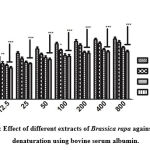 |
Figure 1: Effect of different extracts of Brassica rapa against protein denaturation using bovine serum albumin. |
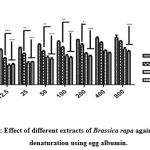 |
Figure 2: Effect of different extracts of Brassica rapa against protein denaturation using egg albumin. |
Bodyweight
The changes in body weight of control, CFA, indomethacin (10 mg/kg), and BREE (200 and 400mg/kg), treated arthritic rats are depicted in fig 3. There was a continuous loss of body weight was seen in all the CFA treated experimental rodents. Treatment of BREE (200 and 400mg/kg) showed a dose-dependent remarkable improvement on the loss of body weight against the CFA induced inflammation.
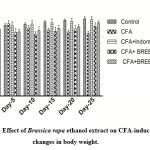 |
Figure 3: Effect of Brassica rapa ethanol extract on CFA-induced changes in body weight. |
Effect on paw swelling
The effect of EEBR on CFA induced paw swelling is depicted in Fig.4 Sub plantar injection of CFA significantly (p<0.001) increased the swelling of the paw in experimental animals. Daily treatment of EEBR (200 and 400mg/kg) and indomethacin(10mg/kg) for twenty-one days after three-day of CFA injection, attenuated the CFA induced paw volume (p<0.001) in Wistar rats compared to CFA treated group.
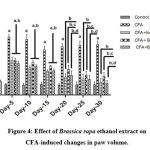 |
Figure 4: Effect of Brassica rapa ethanol extract on CFA-induced changes in paw volume. |
Estimation of Biochemical parameters
Effect on AST and ALT
Fig.5 and 6 illustrate the effect of EEBR on CFA induced changes in the level of serum AST and ALT in Wistar rats. Sub plantar injection of CFA significantly (p<0.001) increased the serum AST and ALT levels in all the groups of animals compared to control. Repeated treatment of EEBR showed a remarkable (p<0.05) curtailment in elevated levels of blood AST and ALT against the CFA induced arthritic group. Moreover, the treatment of a higher dose of 400mg/kg of EEBR treatment showed a remarkable reduction in hepatic biomarker compared to indomethacin treated group.
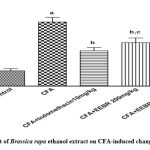 |
Figure 5: Effect of Brassica rapa ethanol extract on CFA-induced changes in AST level. |
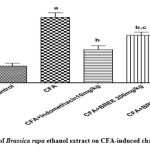 |
Figure 6: Effect of Brassica rapa ethanol extract on CFA-induced changes in ALT level. |
Effect on Serum total Protein
Fig-7 demonstrates the effect of EEBR on CFA induced change in serum total protein concentration in experimental animals. There was a substantial reduction in the level of serum total protein that was observed in all the experimental animals compared to the control group of rodents. Statistical analysis revealed that repeated treatment of EEBR and indomethacin treated rats showed a remarkable (p<0.05) increment in their serum total protein compared to the CFA group.
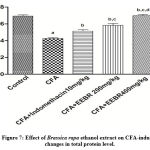 |
Figure 7: Effect of Brassica rapa ethanol extract on CFA-induced changes in total protein level. |
Hematological Parameters
The effect of EEBR on RBC, WBC, Hb, and ESR of adjuvent induced inflammation in experimental aniamls are depicted in Table-1. Statically analysis revealed that sub plantar injection of CFA significantly changed the level of hematological parameters (RBC, hemoglobin were decreased and WBC, erythrocyte sedimentation rate (ESR) were increased) in all the experimental rodents compared to control group of animals. There were significant decrease in RBC from 7.94±0.33 to 6.24±0.33mm3, Hb from 14.35±0.31to 9.6±0.86 g/dL and increase in WBC from 7022±4.2 to 8963±5.26 and ESR from 0.62±0.07 to 2.89±0.08 mm/h. Repeated treatment of EEBR reverse the elevated count of WBC, ESR level, and boost up the Hb and RBC count all most up to normal range in all the experimental animals. Moreover, the treatment of indomethacin attenuated the elevated level of ESR and WBC count but did not show any much more significant effect on RBC count and hemoglobin level compare to EEBR.
Table 1
| Groups | RBC mm3 | Hb% g/dl | WBC mm3 | ESR |
| Control | 7.94±0.33 | 14.35±0.31 | 7022±4.2 | 1.12±0.07 |
| CFA | 6.24±0.33a | 9.6±0.86 a | 8963±5.26 a | 2.89±0.08 a |
| CFA+Indomethacin
(10mg/kg) |
7.35±0.55b | 12.51±0.67b | 7031±6.7b | 0.64±0.04 b |
| CFA+EEBR
(200mg/kg) |
7.1±0.32 a | 11.87±0.71 a | 8085±8.17c | 1.16±0.05 b,c |
| CFA+EEBR
(400mg/kg) |
7.86±0.44b,c | 12.86±0.8 b,d | 7070±7.49 b,d | 0.97±0.10 a,b,d |
Discussion
Medicines have a pivotal role in the treatment of various diseases of human beings since ancient times and herbal drugs are frequently used as a traditional medicine for the relief of pain and inflammation. These drugs can not only prevent the inflamed joint from pain and bone destruction but in comparison to allopathic medicine, these are safe, free from side effects, and suitable for patients 22. The present investigations demonstrate that ethanol extract of Brassica rapa exhibited the inhibition of protein denaturation activity as well as attenuated the CFA induced inflammation in experimental animals. Therefore ethanol extract of Brassica rapa could be an probable option in the treatment of RA.
In the current investigation, the inflammation lowering potential of Brassica rapa extracts was investigated, using BSA and egg albumin method. Protein denaturation is one of the reasons for joint inflammation, which may occur due to loss of secondary and tertiary structure of proteins 23. In the present study, the ethanol extract of Brassica rapa extracts successfully inhibited the denaturation of protein (albumin). Moreover, the ethanol extract showed the highest inhibitory percentage of protein denaturation, close to standard drug. The augmentation in absorbance of test samples concerning control showed that Brassica rapa can decrease the protein denaturation by heat.
Adjuvant induced inflammation model is one of the most accepted screening methods for the assessment of anti-inflammatory drugs because it elicits the similar symptoms of RA as occurs in humans such as pain, redness, and swelling in joints 24. Therefore in the current study adjuvant-induced arthritis model was selected for the demonstration of the anti-arthritic activity of Brassica rapa root. Subcutaneous injection of CFA induce the inflammation in a two different phase (Acute and chronic) 25 and increases the paw volume in experimental animals similar to our previous finding under publication. In the present investigation oral administration of BREE attenuated the CFA induced paw volume in experimental animals that shows that deterioration in the progression of the disease. This might be because of secondary metabolites, potent antioxidant enzymes that decrease tissue injury and promote health 26. Loss of body weight most frequently occurs in RA patients which maybe occur due to loss of appetite and inadequate absorption of nutrients from the gastrointestinal intestine 27. The outcomes of the current investigation demonstrated that there may be a close connection between the loss of body weight and inflammation of joints. Treatment of BREE attenuated the loss of body weight in adjuvant induced inflammation in experimental animals, which could be due to presence of vitamin B and omega 3 fatty acids 28. Our findings were in agreement with the result of 29 which shows that supplementation of vitamin B improves the health status of the patient.
Various researchers have proposed that the estimation of liver biomarkers such as SGOT, SGPT, and total protein is an excellent approach to measure the anti-arthritic potential of test drugs30-32. In the current investigation, CFA caused a significant elevation in the level of SGOT and SGPT and reduction in total protein concentration similar to that of earlier findings which indicate that impairment in hepatic tissue33. Treatment of BREE significantly diminished the activity of SGOT and SGPT and reverses the diminished concentration of protein to normal level in CFA induced arthritic rats and thus demonstrating its ability in protecting the liver against the CFA induced arthritis in experimental animals.
In our study, CFA caused a reduction in the level of hemoglobin and red blood cell count. A low level of hemoglobin represents the anemic condition that may be due to the inadequate absorption of iron or maybe the destruction of premature RBC and decreased the response of erythropoietin towards the bone34. Ethanol extract of Brassica rapa attenuated the elevated count of white blood cells to normal levels in arthritic rats and restored the percentage of hemoglobin, RBC count, and elevated ESR in diseased animals.
Conclusion
The present study revealed that repeated treatment of BREE attenuated the CFA induced symptoms of arthritis such as paw volume in bodyweight and hepatic markers in the experimental rodents. The symptomatic relief in the present study might be due to the presence of flavonoid or any other phytoconstituents present in the extract. Further study is required to confirm the anti-arthritic potential of the extract.
Conflict of Interest
The authors declare that they have no conflict of interests and thankful to GLA University, Mathura, Uttar Pradesh, India for the facility provided for the work. Bhupesh Chandra semwal developed the concept, designed experiment and prepared the manuscript. Neha singh performed the experiment and Shilpi pathak help in the experiment.
Funding Sources
There is no funding source.
References
- Joo SH, Lee J, Hutchinson D, Song YW. Prevalence of rheumatoid arthritis in relation to serum cadmium concentrations: cross-sectional study using Korean National Health and Nutrition Examination Survey data. BMJ open 2019; 9(1): e023233. https://doi.org/10.1136/bmjopen-2018-023233
CrossRef - Porth C. Essentials of pathophysiology: concepts of altered health states. Lippincott Williams & Wilkins. 2011
- Gabriel SE, Crowson CS. Epidemiology of risk factors for, and possible causes of rheumatoid arthritis. Up to Date. (2018).
- Rho YH, Oeser A, Chung CP, Milne GL, Stein CM. Drugs used in the treatment of rheumatoid arthritis: relationship between current use and cardiovascular risk factors. Archives of drug information 2009; 2(2): 34-40.
CrossRef - Nestoriuc Y, Orav EJ, Liang MH, Horne R, Barsky AJ. Prediction of nonspecific side effects in rheumatoid arthritis patients by beliefs about medicines. Arthritis care & research. 2010; 62(6):791-9. https://doi.org/10.1002/acr.20160l
CrossRef - WHO global report on traditional and complementary medicine 2019. https://www.who.int/traditional-complementary-integrative-medicine/Who global report on traditional and complementary medicine. Assessed 15 June 2019.
- Sun R. Economic/Academic interest of Brassica rapa. In X. Wang & C. Kole (Eds.), The Brasica rapa genome (pp. 1–16). Heidelberg, New York, Dordrecht, London: Springer 2015.
CrossRef - Al-Snafi AE. The pharmacological importance of Bassica nigra and Brasica rapa grown in Iraq. J Pharmaceu Biol. 2015; 5: 240–253.
- Bang MH, Lee DY, Oh YJ, Han MW, Yang HJ, Chung HG, Baek NI. Development of biologically active compounds from edible plant sources XXII. Isolation of indoles from the roots of Brassica campestris ssp rapa and their hACAT inhibitory activity. J Kore Socie Appli Biol Chem. 2012; 51: 65–69.
- Hosseini SE, Zahiri S, Aqababa H. Effect of alcoholic extract of Brassica rapa root on formalin test pain in adult male rats. Quarterly of the Horizon of Medical Sciences. 2013; 19: 161–166.
- Li L, Park DH, Li YC, Park SK, Lee YL, Choi HM, Lee M J. Anti-hepatofibrogenic effect of turnip water extract on thioacetamide-induced liver fibrosis. Laboratory Animal Research. 26:1–6. https://doi.org/10.5625/lar.2010.26.1.1
CrossRef - Shin JS, Noh YS, Lee YS, Cho YW, Baek NI, Choi MS, Lee KT. Arvelexin from Brassica rapa suppresses NF-kB-regulated pro-inflammatory gene expression by inhibiting activation of IkB kinase. British J Pharmacol. 2011; 164: 145–158. https://doi.org/10.1111/j.1476-5381.2011.01351.x
CrossRef - Zare A, Khaksar Z, Sobhani Z, Amini M. Analgesic Effect of Valerian Root and Turnip Extracts. World Journal of Plastic Surgery. 2018; 7(3):345-50. https://doi.org/10.29252/wjps.7.3.345
CrossRef - Khandelwal KR. Practical Pharmacognosy. Ninth Edition, Nirali prakashan, Delhi, 2002, pp. 149-15
- Amorim EL, Nascimento JE, Monteiro JM, Peixoto Sobrinho TJS, Araújo TA. A simple and accurate procedure for the determination of tannin and flavonoid levels and some applications in ethnobotany and ethnopharmacology. Functional Ecosystems and Communities 2008; 2(1): 88-94.
- Li FM, Tan J, Nie SP, Dong CJ, Li C. The study on determination methods of total flavonoids in Cyclocarya paliurus. Food Science and Technology, 2006; 4, 34-37.
- Mizushima Y, Kobayashi M. Interaction of anti-inflammatory drugs with serum proteins, especially with some biologically active proteins. The Journal of Pharmacy and Pharmacology. 1968 (3):169-173. DOI: 10.1111/j.2042-7158.1968.tb09718.x.
CrossRef - Hasan UH, Uttra AM, Rasool S. Evaluation of in vitro and in vivo anti-arthritic potential of Berberis calliobotrys. Bangladesh J Pharmaco|. 2015; 10(4):807-19.
CrossRef - Li Y, Kakkar R, Wang J. In vivoand in vitro Approach to Anti-arthritic and Anti-inflammatory Effect of Crocetin by Alteration of Nuclear Factor-E2-Related Factor 2/hem Oxygenase (HO)-1 and NF-κB Expression. Front Pharmacol. 2018; 9:1341. doi:10.3389/fphar.2018.01341
CrossRef - Voon FL, Sulaiman MR, Akhtar MN, Idris MF, Akira A, Perimal EK, Israf DA, Ming-Tatt L. Cardamonin (2′,4′-dihydroxy-6′-methoxychalcone) isolated from Boesenbergia rotunda (L.) Mansf. inhibits CFA-induced rheumatoid arthritis in rats. Eur J Pharmacol 2017; 794:127-134. doi: 10.1016/j.ejphar.2016.11.009.
CrossRef - Zhang Q, Yu Y, Li J, Guan Y, Huang J, Wang Z, Chen J. Anti-arthritic activities of ethanol extracts of Circaea mollis Sieb. & Zucc.(whole plant) in rodents. J Ethnopharmacol 2018; 225: 359-366.
CrossRef - Ekor M. The growing use of herbal medicines: issues relating to adverse reactions and challenges in monitoring safety. Front Pharmacol 2014; 4:177. https://doi.org/10.3389/fphar.2013.00177
CrossRef - Prasad SB, Yashwant, Aeri V. in vitro anti-inflammatory activity of Raupya (Silver) Bhasma. J Chem Pharm Res. 2013;5:194-7.
- Bendele A. Animal models of rheumatoid arthritis. J Musculoskelet Neuronal Interact 2001; 1(4): 377-85
- Saleem A, Saleem M, Akhtar MF, Shahzad M, Jahan S. Polystichum brauniiextracts inhibit Complete Freund’s adjuvant-induced arthritis via upregulation of I-κB, IL-4, and IL-10, downregulation of COX-2, PGE2, IL-1β, IL-6, NF-κB, and TNF-α, and subsiding oxidative stress. 2020; https://doi.org/10.1007/s10787-020-00688-5
CrossRef - Pérez-Cano FJ, Castell M. Flavonoids, Inflammation and Immune System. Nutrients 2016; 8(10): https://doi.org/10.3390/nu8100659
CrossRef - Guo Z, Xu HY, Xu L, Wang SS, Zhang XM. In vivo and in vitro immunomodulatory and anti-inflammatory effects of total flavonoids of Astragalus. Afri J Tradi Complemen Alter Medici 2016;13(4): 60-73.
CrossRef - Javed A, Ahmad A, Nouman M, Hameed A, Tahir A, Shabbir U. Turnip (Brassica Rapus L.): a natural health tonic. Braz J Food Tech. 2019;22:e2018253 https://doi.org/10.1590/1981-6723.25318
CrossRef - Böhmer BM, Roth-Maier DA. Effects of high-level dietary B-vitamins on performance, body composition and tissue vitamin contents of growing/finishing pigs. J Anim Physiol Anim Nutr (Berl). 2007;91(1-2):6-10. doi:10.1111/j.1439-0396.2006.00635.x
CrossRef - Curtis JR, Beukelman T, Onofrei A, Cassell S, Greenberg JD, Kavanaugh, A, Reed G, Strand V, Kremer JM. Elevated liver enzyme tests among patients with rheumatoid arthritis or psoriatic arthritis treated with methotrexate and leflunomide. Annals of the rheumatic diseases 2010; 69(1): 43–47. https://doi.org/10.1136/ard.2008.101378
CrossRef - Li Y, Kakkar R, Wang J. In vivo and in vitro Approach to Anti-arthritic and Anti-inflammatory Effect of Crocetin by Alteration of Nuclear Factor-E2-Related Factor 2/hem Oxygenase (HO)-1 and NF-κB Expression. Frontiers in pharmacology 2018; 9: https://doi.org/10.3389/fphar.2018.01341
CrossRef - Kumar V, Bhatt PC, Sharma K, Rahman M, Patel DK, Sethi N, et al. Melastoma malabathricum Linn attenuates complete freund’s adjuvant-induced chronic inflammation in Wistar rats via inflammation response. BMC complementary and alternative medicine. 2016; 16(1):510.
CrossRef - Srivastava S, Singh P, Jha KK, Mishra G, Srivastava S, Khosa RL. Evaluation of anti-arthritic potential of the methanolic extract of the aerial parts of Costus speciosus. J Ayu integ medic 2012; 3(4): 204–208. https://doi.org/10.4103/0975-9476.104443
CrossRef - Zhu L, Zhang Z, Xia N, Zhang W, Wei, Y, Huang J, Yang L. Anti-arthritic activity of ferulic acid in complete Freund’s adjuvant (CFA)-induced arthritis in rats: JAK2 inhibition. Inflammopharmacology 2020; 28: 463–473.
CrossRef










